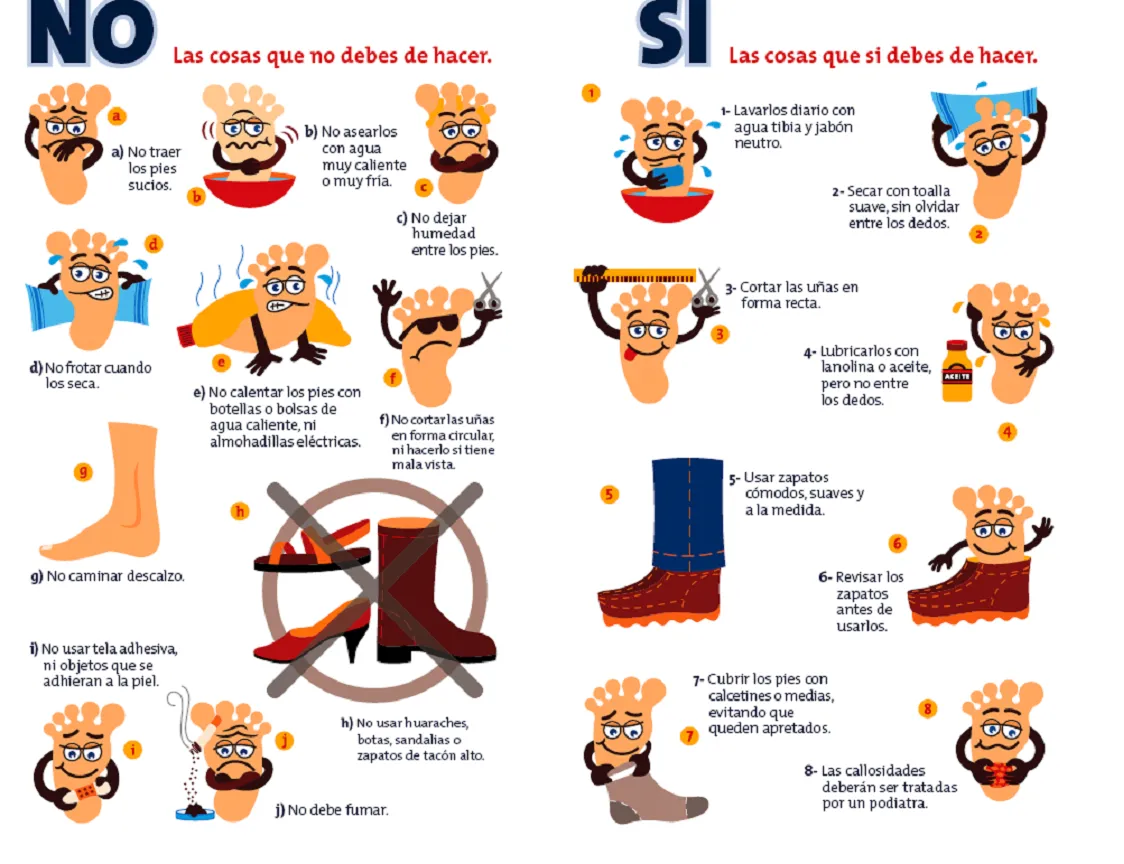It is the disorder of the diabetic feet caused by the disease of the peripheral arteries that irrigate the foot, often complicated by damage to the peripheral nerves of the foot and infection.Due to the occlusion of the arteries that carry blood at the feet, gangrene occurs.
The foot of the diabetic patient is very sensitive to any form of trauma: heel and bone prominences are especially vulnerable.
Damage to the peripheral nerves of the feet cause sensory disorders, foot ulcers, skin atrophy.
It is frequent in diabetic patients that the lesions of the so -called diabetic foot transcend without pain, due to which the injury is usually aggravated before the patient asks for specialized help.
how to avoid diabetic foot injuries?
Risk patients (elderly and those who have poor circulation), are recommended the following routine feet care:
* Every day, the feet must be washed (although not soaked) in hot water, whose temperature has been previously tested by hand.They must be dry with meticulousness, paying special attention to interdigital spaces (between fingers).
* Feet nails should be cut carefully.Patients with bad view or trembling hands should ask other people to cut them.The nails should not be shorter than the end of the finger.
* The feet should be inspected frequently, looking carefully, dry areas and skin fissures, especially around the nails and in interdigital spaces.They must be sprinkled with talcum, if the skin is wet, or coated with moisturizer, if the skin is dry.Plants must be inspected with a mirror or by another person.Special care must be taken with calluses and hardness, which must be treated by a podiatrist.No powerful antiseptics (iodine) should be used.
* If blisters or infections appear, the doctor should immediately be consulted.
* Hot water bags should not be used.It is preferable to use socks.
* Electric blankets can be used, but they must go out before getting into bed.
* Shoes must adjust well (without tightening) and be comfortable, leaving room for the fingers to rest in their natural position.
* New shoes should be put progressively, every time for a slightly longer time.
* Cotton or wool socks should be used, better than nylon.They must be of the right size and not have left -handed or seams that may produce pressures.They must be changed daily.
* Walking with barefoot feet is dangerous, since a small wound can take a long time to heal.
* Stop smoking.Tobacco is very harmful to diabetics, because it produces vasoconstriction.
* Another aspect of prevention that deserves some attention is the design of custom footwear for diabetics with very vulnerable feet.These shoes must be designed to redistribute the forces that supports the foot.
Care of existing lesions
* A detailed examination of both feet must be done, with a careful inspection of the heels and interdigital spaces.
* The status of circulation, and sensitivity should be evaluated in detail.
* The temperature and color of the skin, the vascular response to the elevation of the member must be taken into account, that is, if there are changes in the color according to the limb posture, the change in the amount of hair in the leg.
* A color photograph is useful to judge the progression of lack of irrigation.
The treatment of the diabetic foot is based on:
* Protection against damage that is associated with the loss of sensitivity caused by nerve injuryperipherals
* Treatment of infection that may appear.
* Improvement of circulation avoiding the use of shoes or tight garments.
* Medical control of diabetes, that is, verifying that glucose levels are within the allowed limits.
Fountain:
Merck Manual, Eighth Edition.Doyma editions.1989. Barcelona
www.tuotromedico.com
Warning
The information you will find in this article does not intend to replace the necessary medical advice or the need for a medical professional treatment for a medical condition
o Transorno in your health.
You should always consult a doctor in the face of any doubt about your health and before starting a new treatment with medicines, diet or physical exercise program




